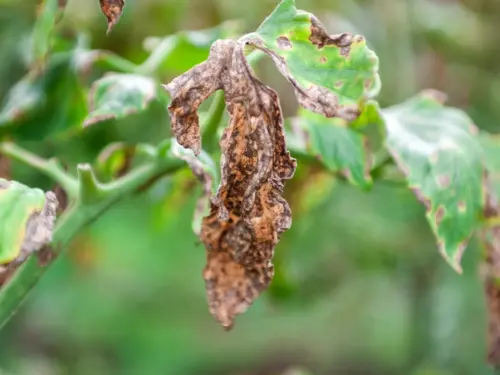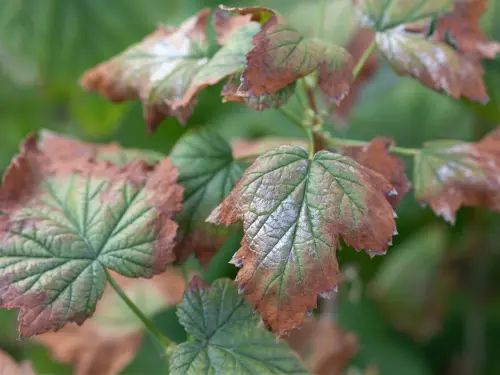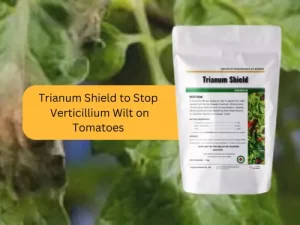How Can I Naturally Stop Verticillium Wilt on Tomatoes?
Verticillium wilt on tomatoes is a terrible disease that spreads all over the world and destroys fields. Using biological control fungicides are the best way to fight the disease.
Biological control fungicides such as Trianum-Shield are a hopeful way to fight verticillium wilt on tomatoes. Using this verticillium wilt fungicide leads to healthier crops and more sustainable farming. This eco-friendly approach eradicates the disease and maintains soil microbial balance. Balanced microbes lead to stronger, more productive plants.

This blog talks about how to treat verticillium wilt on tomatoes with verticillium wilt fungicide. Using natural products can help in verticillium wilt treatment. This improves tomato plant health and output while having the least amount of effect on the environment.
What does Verticillium Wilt Look Like?
Verticillium wilt in tomatoes initially manifests as yellowing and wilting of lower leaves, progressing upwards. Infected leaves may curl, dry out, and drop prematurely, while stems exhibit brown discoloration within.
The disease hampers water and nutrient flow, leading to stunted growth and reduced yields. Symptoms often appear on one side of the plant or a single branch, making the plant look uneven or partially affected, which is distinctive of this fungal infection.
Verticillium wilt on tomatoes: why does it happen?
- Soil-Borne Pathogens: Verticillium wilt in tomatoes is mostly caused by fungi Verticillium albo-atrum and Verticillium dahliae. These fungi can persist in soil for years without a host plant, threatening subsequent tomato crops. Their survival in soil underscores the importance of crop rotation and diligent soil management. Adopting these practices is vital to decrease the likelihood of disease.
- Different Types of Tomatoes: Not all types of tomatoes are resistant to verticillium wilt tomato to the same degree. The susceptibility of some tomato types greatly raises the chance that disease will show up. To control this disease, it is important to breed and choose varieties that are genetically resistant to Verticillium fungi. This shows how genetics can help avoid diseases.

- Conditions: Verticillium wilt tomato grows best in cool to moderate temperatures and wet conditions, which are typical in many places where tomatoes are grown in the spring and fall. These conditions make it easier for the fungi to grow and spread, so it’s important to handle water well and choose the right sites to stop diseases from spreading.
- Poor Crop Rotation: Growing tomatoes or other plants that are easily infected in the same soil over and over again raises the number of Verticillium fungi in the soil, which increases the risk of disease. Fungal populations in the soil can be greatly reduced by using a crop rotation system with non-host crops. This shows how farming methods can affect the spread of disease.
- Verticillium wilt may spread through contaminated tools or by introducing infected plants to clean areas. Sanitation and hygiene are critical in tomato growing areas to prevent the disease’s introduction and spread.
How can I naturally stop Verticillium wilt on tomatoes?
- Crop Rotation and Soil Management: Control Verticillium wilt by rotating crops annually and avoiding planting tomatoes or susceptible plants in the same soil for three to four years. This method helps lower the number of fungi in the dirt. Adding organic matter to soil can improve its health and make it drain better, which lowers the risk of infection because the fungus grows best in areas that don’t drain well.
- You can use tomato types that are resistant to Verticillium wilt by planting them. This is an important part of natural control. Breeders have developed resistant varieties that seldom succumb to infection, reducing the prevalence and severity of diseases. Look for a “V” on plant tags or seed packets indicating Verticillium resistance.
- Take Care of Healthy Plants: Healthy tomato plants resist diseases like Verticillium wilt more effectively. Ensure adequate spacing for airflow and water regularly to avoid stress. Use mulch to maintain warm, moist soil conditions. A plant that is healthy is better able to fight off diseases and heal from damage.

- Use of Natural Fungicide for Verticillium Wilt Treatment: One new way to keep Verticillium wilt under control in tomatoes is to use natural fungicides like Trianum-Shield, which is made from the main ingredient Trichoderma harzianum. It is a good fungus that forms a mutual relationship with plant roots. This makes the plant’s natural defenses stronger against pathogens like Verticillium wilt. It not only stops the disease but also helps plants grow healthier and stronger by fighting with harmful fungi for space and food. This method is in line with eco-friendly gardening practices because it helps keep the soil ecosystem balanced and gets rid of plant diseases successfully.
Other Plant Wilting and Solution
You can find other plant wilting problems and their solutions by clicking on the links below, along with how to treat verticillium wilt on tomatoes.
- Damping off of tomato
- Bacterial wilt on tomatoes
- Gray mold on tomato
- Fusarium wilt in eggplant
- Fusarium wilt on watermelon
- Fusarium wilt of banana
- Fusarium wilt of tomato
References:
- Jabnoun-Khiareddine, Hayfa, et al. “Biological control of tomato Verticillium wilt by using indigenous Trichoderma spp.” The African Journal of Plant Science and Biotechnology 3.1 (2009): 26-36.
- Mirmajlessi, Seyed Mahyar, et al. “Screening of native Trichoderma harzianum isolates for their ability to control Verticillium wilt of strawberry.” (2016): 397-404.




Leave a Reply